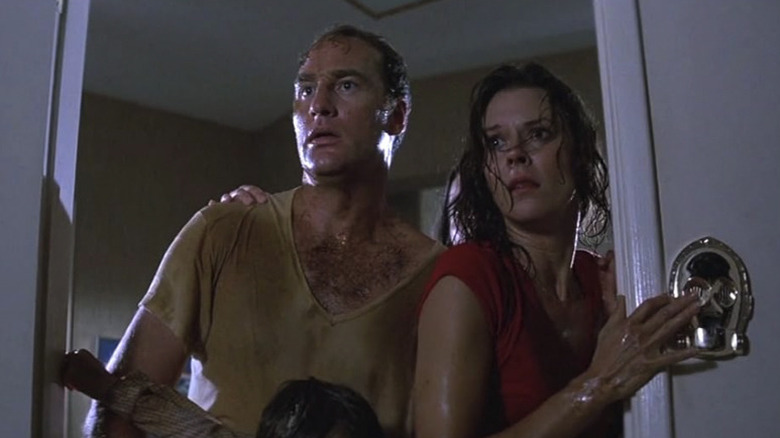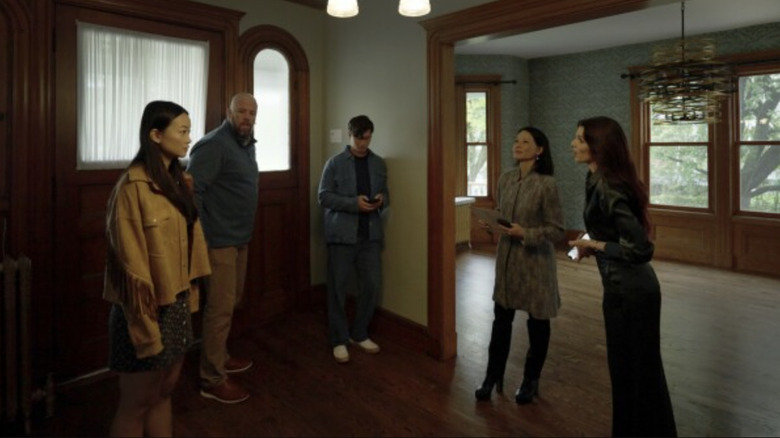Presence Has A Delightful Easter Egg Only Horror Fans Will Notice
Steven Soderbergh's "Presence" is steadily building a reputation as an unconventional ghost story, with the maverick director choosing to, in effect, play the ghost himself and shoot the entire film from the ghost's point of view. As my review out of the 2024 Sundance Film Festival (where the film premiered) explains, this technique allows "Presence" to straddle the line between a found footage movie and a character POV film in a subversively clever way: While the camera is disembodied enough to move at will and be present in situations that another human person couldn't observe, Soderbergh never lets us forget the fact that there's an identity to this point of view, even if the entity itself doesn't know who they are at first.
This perspective means that "Presence" is less a terrifying supernatural horror film and more of a thoughtful, character-based thriller, because after all, we know where the ghost is at all times even when the other characters don't. It also undoubtedly makes "Presence" a milestone movie in the annals of films about haunted houses, switching up what's been the norm in the subgenre for decades now. Soderbergh seems to be well aware of this fact, as seen in a delightful easter egg within the film which horror fans and particularly Tobe Hooper fans will spot right away. In paying homage to 1982's "Poltergeist" with this easter egg, Soderbergh earmarks "Presence" as the next step in the haunted house film's evolution.
The importance of Poltergeist in haunted house cinema
The haunted house movie was born from the traditions seen in Gothic literature, wherein some dark, terrible, and mysterious goings-on were typically relegated to distant and remote (not to mention large and foreboding) homes. As such, many of the haunted house movies from classic Hollywood and beyond saw characters traveling to these ominous places, usually discovering at some point that some ancient curse or legend or incident occurred there many years ago, as in one of the seminal works of the subgenre, 1944's "The Uninvited." Then, around the 1960s, haunted house movies began to expand beyond the "destination haunted house" that had been the tradition. It saw characters actively set out to investigate the paranormal (as in "The Haunting" and "The Legend of Hell House") as well as try and endure or exorcise the evil spirits that were already living with them (as in "The Amityville Horror").
"Poltergeist" was the first mainstream horror film to bring the haunted house out of the remote corners of literal distance and the figurative past. Instead, it brought paranormal activity right to every suburbanite's front door. In the film, the family at the center of the story doesn't buy a spooky old mansion with a history of violence, but rather a brand spanking new luxury home. Of course, it turns out that the house may be new but the land it sits on is old, and the unscrupulous developers did not make the homeowners aware of how they were unable to relocate the cemetery that once stood there (or rather, still does). "Poltergeist" is when the haunted house movie literally came home.
How Presence pays homage to Poltergeist
For the beginning and end titles of "Presence," the font used is one which is almost exactly the same as seen in "Poltergeist." It's essentially Helvetica Medium (or possibly Bold) with each letter having a white outline, and its eerie simplicity still has a spooky power to anyone who remembers the marketing materials for "Poltergeist." Ironically, those titles are the first images seen in both films, hence why the font seems to be a deliberate homage on the part of "Presence."
David Koepp's script for "Presence" is rooted in ghost story and haunted house movie tradition: The family in the film are going through numerous financial and interpersonal issues; when they stumble onto the supernatural presence in their new home, they're skeptical but still decide to investigate (and involve a medium in this, naturally); and there are several mysteries to be solved — not just who the ghost may have been and what it wants, but also what might be responsible for the deaths of several teen girls around town. In this way, it's a bit more classical than even "Poltergeist" was. Yet Soderbergh's choice to tell the story this way, not only emphasizing the spirit's POV but leaning on sorrow more than scares, gives "Presence" that subversive twist which puts it on par with Hooper's film.
The "Poltergeist" easter egg isn't the only connection "Presence" has with other movies (there's a connection between the film and Christopher Nolan's "Interstellar," though to explain why would be a spoiler), but it's the most telling one. If "Poltergeist" was Hooper's way of announcing to Americans that we needed to acknowledge our country's sordid history before we can ever truly move on, then "Presence" is Soderbergh and Koepp acknowledging how so many of us feel powerless to stop the horrific events we see in front of us. If we're not careful, we might all end up like the ghost in the film, unable to move on until we right a wrong that we failed to recognize when we were alive. Maybe "Presence" is pretty scary after all.


